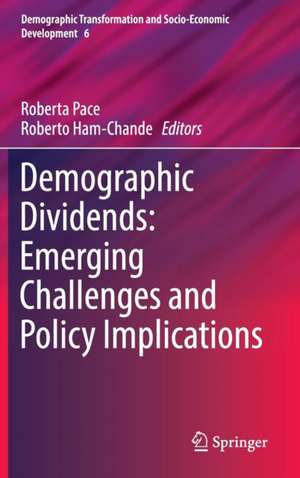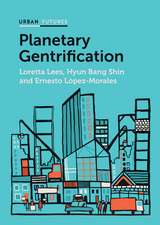Demographic Dividends: Emerging Challenges and Policy Implications: Demographic Transformation and Socio-Economic Development, cartea 6
Editat de Roberta Pace, Roberto Ham-Chandeen Limba Engleză Hardback – 9 aug 2016
The book first traces the common link between policies that contribute to fertility transition as well as create the right kind of environment for reaping the benefit of demographic dividend. Next, it explores different countries and regions who are at different levels of development. It assesses the long term impact of gender equality on economic growth and development in Latin America; describes the life-cycle saving patterns of Mexican households; and examines demographic determinants of economic growth in BRICS. The book also offers demographic and economic analysis of the Mediterranean area, Sub-Saharan Africa, and New Zealand.
The comparison between the different territorial contexts allow for the identification of three typologies of demographic dividend: the first dividend, when the working population grows faster than total population, the second dividend, as active generations get older and invest their savings in the production system of their country, and the third dividend, based on the coexistence of two populations age structure strongly contrasting.
Overall, this book argues for the need to capitalize on the opportunities that come from the demographic dividend by investing heavily in education programs, training programs for the population working age, health programs, the creation of health insurance systems as well as programs to reduce or increase fertility levels.
| Toate formatele și edițiile | Preț | Express |
|---|---|---|
| Paperback (1) | 382.36 lei 6-8 săpt. | |
| Springer International Publishing – 20 iun 2018 | 382.36 lei 6-8 săpt. | |
| Hardback (1) | 389.70 lei 6-8 săpt. | |
| Springer International Publishing – 9 aug 2016 | 389.70 lei 6-8 săpt. |
Preț: 389.70 lei
Nou
Puncte Express: 585
Preț estimativ în valută:
74.57€ • 79.74$ • 62.17£
74.57€ • 79.74$ • 62.17£
Carte tipărită la comandă
Livrare economică 17 aprilie-01 mai
Preluare comenzi: 021 569.72.76
Specificații
ISBN-13: 9783319327075
ISBN-10: 3319327070
Pagini: 165
Ilustrații: XI, 184 p. 77 illus.
Dimensiuni: 155 x 235 x 13 mm
Greutate: 0.45 kg
Ediția:1st ed. 2016
Editura: Springer International Publishing
Colecția Springer
Seria Demographic Transformation and Socio-Economic Development
Locul publicării:Cham, Switzerland
ISBN-10: 3319327070
Pagini: 165
Ilustrații: XI, 184 p. 77 illus.
Dimensiuni: 155 x 235 x 13 mm
Greutate: 0.45 kg
Ediția:1st ed. 2016
Editura: Springer International Publishing
Colecția Springer
Seria Demographic Transformation and Socio-Economic Development
Locul publicării:Cham, Switzerland
Cuprins
Introduction : Roberto Roberta Pace and Ham-Chande.- The Common Link between Policies Conducive to both Demographic Dividend and Fertility Transition: Anrudh K. Jain.- Population Ageing, Demographic Dividend and Gender Dividend: Assessing the Long Term Impact of Gender Equality on Economic Growth and Development in Latin America: Tim Miller, Paulo Saad and Ciro Martínez.- Demographic Dividends and Household Saving in Mexico: Isalia Nava-Bolaños and Roberto Ham-Chande.- Demographic Transition in Sub-Saharan Africa: Implications for Demographic Dividend: Yoonjoung Choi.- Age-Structural Transition and Demographic Windows around the Mediterranean: Maria Carella and Alain Parant.- The Potential Collateral Demographic Dividend: Natalie Jackson.- Beyond the Demographic Dividend: Demographic Transitions and Empirical Evidence in Italy: Roberta Pace and Nadia Mignolli.
Textul de pe ultima copertă
This book examines potential economic opportunities that countries can experience when fertility rates fall and the average life expectancy of the working age population increases. It presents detailed demographic and economic analysis of middle-income countries throughout the world in order to show how these countries can take advantage of this demographic bonus.
The book first traces the common link between policies that contribute to fertility transition as well as create the right kind of environment for reaping the benefit of demographic dividend. Next, it explores different countries and regions who are at different levels of development. It assesses the long term impact of gender equality on economic growth and development in Latin America; describes the life-cycle saving patterns of Mexican households; and examines demographic determinants of economic growth in BRICS. The book also offers demographic and economic analysis of the Mediterraneanarea, Sub-Saharan Africa, and New Zealand.
The comparison between the different territorial contexts allow for the identification of three typologies of demographic dividend: the first dividend, when the working population grows faster than total population, the second dividend, as active generations get older and invest their savings in the production system of their country, and the third dividend, based on the coexistence of two populations age structure strongly contrasting.
Overall, this book argues for the need to capitalize on the opportunities that come from the demographic dividend by investing heavily in education programs, training programs for the population working age, health programs, the creation of health insurance systems as well as programs to reduce or increase fertility levels.
Caracteristici
Gives a multi-dimensional approach to the Demographic Dividend Analysis Identifies three typologies of demographic dividend in different world areas Collects the experiences of middle-income countries to better understand the opportunities that could be obtained by detailed demographic and economic analysis

























